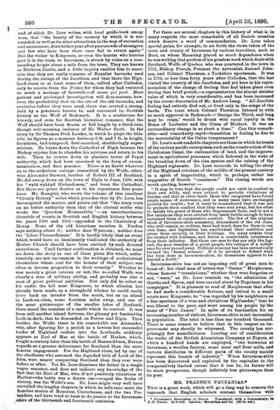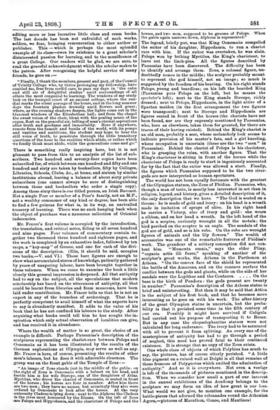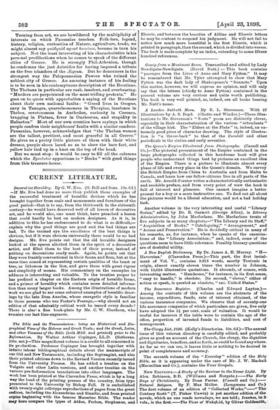MR. FRAZER'S PACTSANIA.S.* THIS is a great work, which will
go a long way to remove the reproach that English scholars content themselves with
• Pausanias's Description of Greece. Translated, with • Commentary. bf J. G. Frazer. In 6 yols. London: Macmillan and 00. (Z6 naLi
editing more or less lucrative little class and cram books. The last decade has been not unfruitful of such works, seldom, we fear, bringing remuneration to either author or publisher. This — which is perhaps the most splendid example of its class—owes its existence to a great scholar's disinterested passion for learning, and to the munificence of a great College. Our readers will be glad, we are sure, to read the graceful acknowledgment which the scholar makes to the patron. After recognising the helpful service of many friends, he goes on :—
" Finally, I thank the members, present and past, of the Council of Trinity College who, by thrice prolonging my fellowship, have enabled me, free from sordid care, to pass my days in the calm and still air of delightful studies' amid surroundings of all others the most congenial to learning. The windows of my study look on the tranquil court of an ancient college, where the sun- dial marks the silent passage of the hours, and in the long summer days the fountain plashes drowsily amid flowers and grass ; where, as the evening shadows deepen, the lights come out in the blazoned windows of the Elizabethan hall; and from the chapel the sweet voices of the choir, blent with the pealing music of the .organ, float on the peaceful air, telling of man's eternal aspirations after truth and goodness and immortality. Here if anywhere, remote from the tumult and bustle of the world, with its pomps and vanities and ambitions, the student may hope to hear the still voice of truth, to penetrate through the little transitory questions of the hour to the realities which abide, or rather which we fondly think must abide, while the generations come and go."
There is something really inspiring here, but it is not pleasant to pass from this to an analysis of the list of sub- scribers. Two hundred and seventy-four copies have been subscribed for, of which between one hundred and fifty and one hundred and sixty are taken by booksellers, fifty by Colleges, Libraries, Schools, Clubs, &c., at home, and sixteen by similar institutions abroad, leaving a balance of about sixty private
subscribers (one cannot always be sure of distinguishing between these and booksellers who order a single copy). Among these sixty there is one titled person, an Irish Baronet. Not a single Peer or member of a Peer's family, not an M.P., not a wealthy commoner of any kind or degree, has been able
to find a few guineas for what is, in its way, an unrivalled treasury of learning. There was no such hanging back when the object of purchase was a nauseous collection of Oriental indecencies.
Mr. Frazer's first volume is occupied by the introduction, the translation, and critical notes, filling in all seven hundred
and nine pages. Four volumes of commentary contain to- gether two thousand three hundred and eighteen pages, and the work is completed by an exhaustive index, followed by ten maps, a "key-map" of Greece, and one for each of the divi- sions of the description. (Elie, it should be said, occupies two books,—V. and VI.) These bare figures are enough to show what accumulated stores of knowledge, patiently gathered by years of unsparing labour, have been brought together in these volumes. When we come to examine the book a little closely this general impression is deepened. All that antiquity had to say on the subject, all the speculations that modern scholarship has based on the utterances of antiquity, all that oould be learnt from libraries and from museums, have been laid under contribution. Mr. Frazer tells us that he is not an expert in any of the branches of archeology. That he is perfectly competent to avail himself of what the experts have to say is abundantly manifest. It adds to the value of his book that he has not confined his labours to the study. After acquiring what books could tell him he has sought the in- spiration which only actual observation of localities can give, and has received it in abundance.
Where the wealth of matter is so great, the choice of an example is difficult. Perhaps Pausanias's description of the sculptures representing the chariot-race between Pelops and -Oenomaiis as it has been illustrated by the results of the German explorations at Olympia, may serve as well as any. Mr. Frazer is here, of course, presenting the results of other men's labours, but he does it with admirable clearness. The .group was on the front gable of the Temple of Zens : -
"An image of Zeus stands just in the middle of the gable : on the right of Zeus is Oenomans with a helmet on his head, and 'beside him is his wife Sterope, one of the daughters of Atlas. Myrtilus, who drove the chariot of Oenomaiis, is seated in front of the horses ; his horses are four in number. After him there are two men ; they have no names, but seemingly they also were ordered by Oenomaiis to look after the horses. At the very
• extremity Cladeus is lying down : next to the Alpheus the Cladeus u the river most honoured by the Eleans. On the left of Zeus Are Pelops and Hippodamia, and the charioteer of Pelops and the
horses, and two men, supposed to be grooms of Pelops. When the gable again narrows down, Alpheus is represented."
The legend, briefly put, was that King Oenomaiis compelled the suitor of his daughter, Hippodamia, to run a chariot race with him. If the suitor was overtaken, he was slain. Pelops won by bribing Myrtilus, the King's charioteer, to leave out the linch-pins. All the figures described by Pausanias have been discovered. The difficulty has been to identify and arrange them. Zeus, a colossal figure, un- doubtedly comes in the middle; the sculptor probably meant to represent the god himself, not an image ; so much is suggested by the freedom of his bearing. On his right stands Pelops, young and beardless; on his left the bearded King (Pausanias puts Pelops on the left, but he means the spectator's left) ; next to the King stands Sterope, richly dressed ; next to Pelops, Hippodamia, in the light attire of a Spartan maiden (in the first arrangement the two figures were transposed); next to Sterope and Hippodamia are figures seated in front of the horses (the chariots have not been found, nor are they expressly mentioned by Pansanias, who, here as elsewhere, takes them for granted, for there are traces of their having existed). Behind the King's chariot is an old man, probably a seer, whose melancholy look seems to indicate prevision of his master's fate, and a girl kneeling, whose occupation is uncertain (these are the two " men " in Pansanias). Behind the chariot of Pelops is his charioteer, who is grasping the reins, with another figure. That the King's charioteer is sitting in front of the horses while the charioteer of Pelops is ready to start is ingeniously accounted for by the fact that the suitor was allowed a start. Finally, the figures which Pausanias supposed to be the two river- gods are now interpreted as human spectators.
The world has not been equally fortunate with the greatest of the Olympian statues, the Zeus of Phidias. Pansanias, who, though a man of taste, is mostly less interested in art than in religion, legend, and history, gives a detailed description of it, the only description that we have. "The God is seated on a throne he is made of gold and ivory: on his head is a wreath made in imitation of sprays of olive. In his right hand he carries a Victory, also of ivory and gold : she wears a ribbon, and on her head a wreath. In the left hand of the god is a sceptre, curiously wrought in all the metals : the bird perched on the sceptre is an eagle. The sandals of the god are of gold, and so is his robe. On the robe are wrought figures of animals and the lily flowers." The wealth of accessories was one of the remarkable features of Phidiaa'r work. The grandeur of a solitary conception did not con- tent him. " Momenta omnia," says the elder Pliny, "capacia artis illi fuere," speaking of another of the sculptor's great works, the Athena in the Parthenon at Athens. " On the convex face of the shield he represented the battle of the Amazons, and on the concave surface the conflict between the gods and giants, while on the side of her sandals were the Lapithae and the Centaurs. . . . . On the base is the birth of Pandora : the gods present are twenty in number." Pausanias's description of the Athens statue is brief and uninteresting. But then it may be said that Attica is the subject of his first book, and that he becomes more interesting as he goes on with his work. The after•history of the great Olympian statue is uncertain, but the proba- bility is that it perished some time in the fifth century of our era. Possibly it might have survived if Caligula had carried out his purpose of transporting it to Rome. Bat in any case the chryselephantine statues were not calculated for long endurance. The ivory had to be saturated with oil to prevent it from splitting. As every one of the masterpieces of antiquity has had to go through a period of neglect, this need has proved fatal to their continued existence. It is strange that so copy of the Zeus exists.
One whole class of objects of which Polybius has much to say, the pictures, has of course utterly perished. "A little blue pigment on a ruined wall at Delphi is all that remains of those frescoes of Polygnotus which excited the admiration of antiquity." And so it is everywhere. Not even a vestige is left of the thousands of pictures mentioned in the descrip- tion. When we consider how small a part of our interest in the annual exhibitions of the Academy belongs to the sculpture we may form an idea of how great is our loss. What would we not give, to mention one example, for the battle-pieces that adorned the colonnades round the Athenian Agora,—pictures of Marathon, Oenoe, and Mantinea! Turning from art, we are bewildered by the multiplicity of interests on which Pausanias touches. Folk-lore, legend, history, religion, curiosities of Nature, agriculture, trade, we might almost say quidquid agunt hominea, become in turn his subject. Not the least interesting of his characteristics is his personal predilections when he comes to speak of the different cities of Greece. He is strongly Phil-Athenian, though he condemns the just Aristides for having imposed a tribute on the free islanders of the .2Egean. But he denounces in the strongest way the Peloponnesian Powers who ruined the noblest city of Greece. An amusing instance of his feeling is to be seen in his contemptuous description of the Bceotians. The Thebans in particular are rash, insolent, and overbearing. "Murders are perpetrated on the most trifling pretexts." He goes on to quote with approbation a saying of the Bceotians about their own national faults : " Greed lives in Oropus, envy in Tanagra, quarrelsomeness in Thespiae, insolence in Thebes, covetousness in Anthedon, curiosity in Corona, bragging in Plataea, fever in Onchestus, and stupidity in Haliartus." Most of oar own counties have sayings in which people confess their neighbours' faults with a similar candour. Pausanias, however, acknowledges that "the Theban women are the tallest, prettiest, and most graceful in all Greece." He gives us a pretty little picture of them with their white dresses, purple shoes laced so as to show the bare feet, and yellow hair tied up in a knot on the top of the head.
But we must stop: it would be easy to fill all the columns which the Spectator apportions to " Books " with good things from this treasure-house.




































 Previous page
Previous page